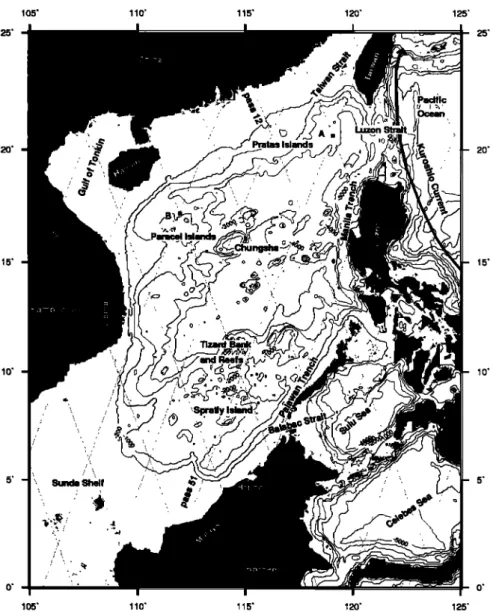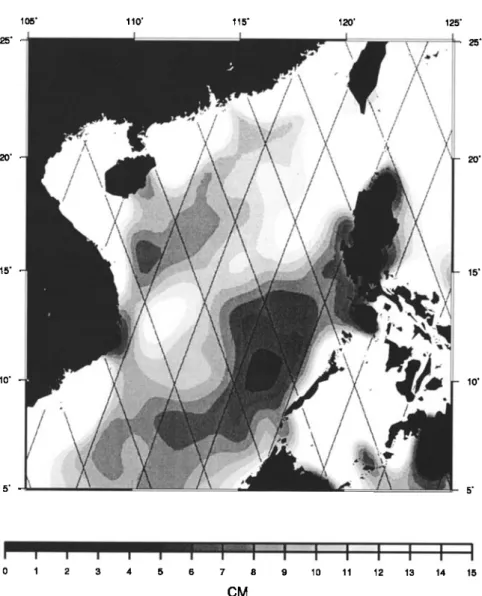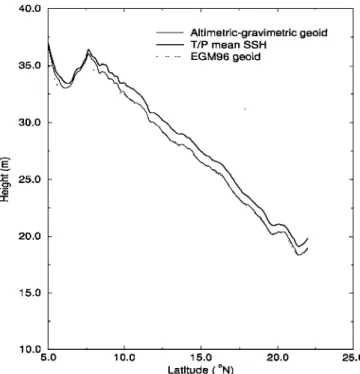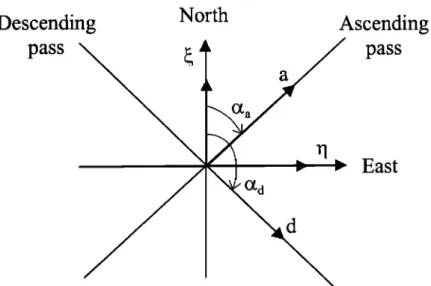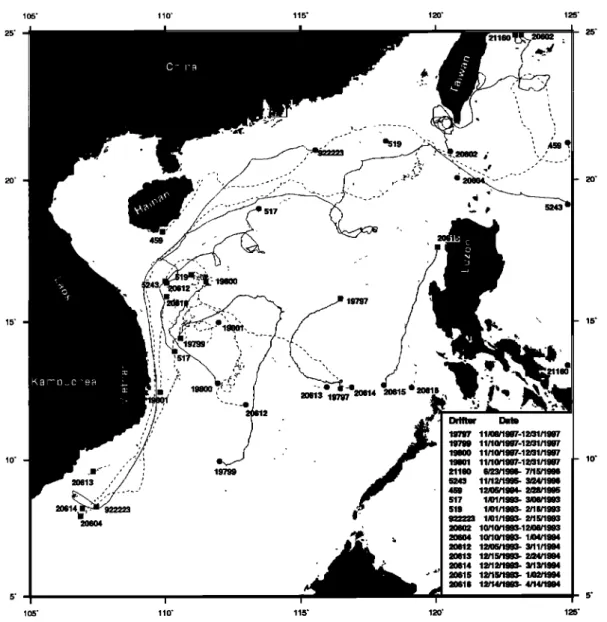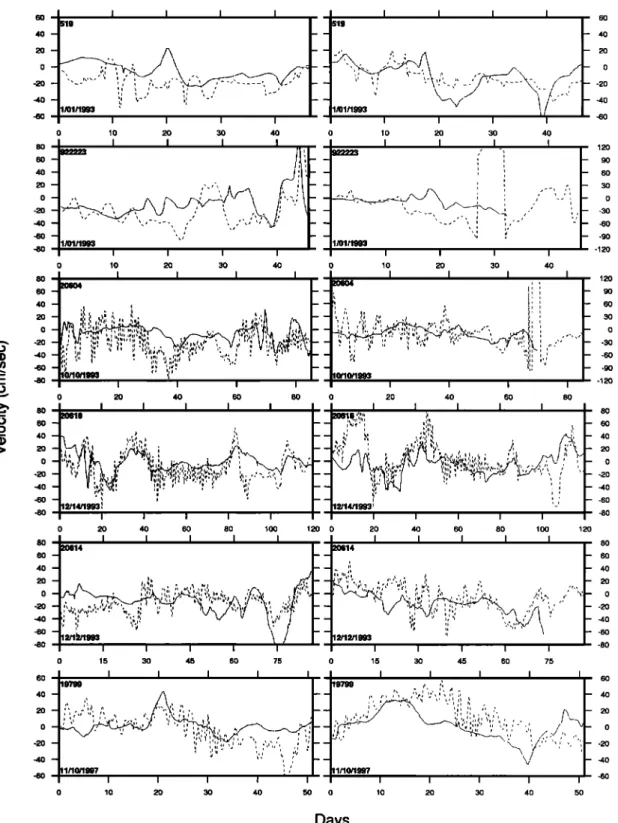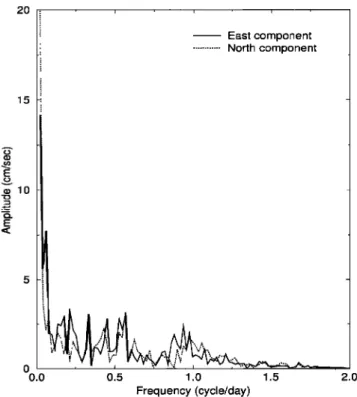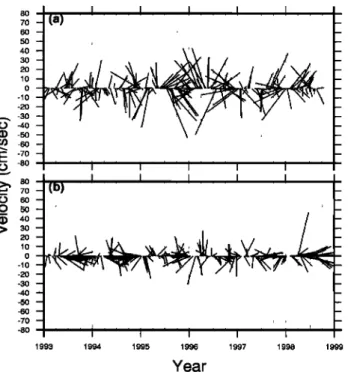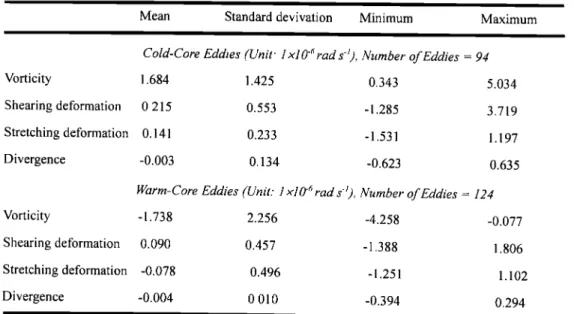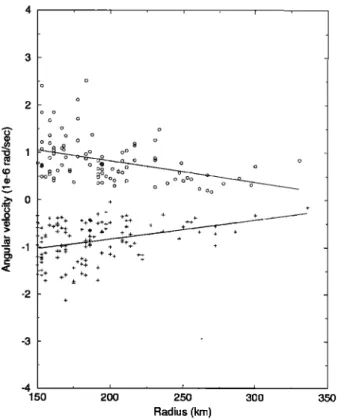JOURNAL OF GEOPHYSICAL RESEARCH, VOL. 105, NO. C10, PAGES 23,943-23,965, OCTOBER 15, 2000
Circulations and eddies over the South China Sea derived
from TOPEX/Poseidon altimetry
Cheinway
Hwang and Sung-An
Chen
Department of Civil Engineering, National Chiao Tung University, Hsinchu, Taiwan
Abstract. TOPEX/Poseidon (T/P) altimeter data were used to derive time-varying circulation and
eddies over the South China Sea (SCS) for 1993-1999. Large variabilities
of sea surface
heights
and dense
distribution
of eddies were found to occur along a band across
the SCS basin. A cross-
over method is introduced
to compute
pointwise velocity components.
The T/P-derived circula-
tions and eddies are consistent
with the drifter results
from the World Ocean Circulation
Experi-
ment data center. (1) Because
of monsoons,
the SCS circulation
is largely cyclonic in winter, is
largely anticyclonic
in summer,
and is modulated
interannually
by El Nifio- Southern
Oscillation.
(2) Both cold- and warm-core eddies
were found in the waters east of Vietnam, west of Luzon, and
west of the Luzon Strait, but their times of occurrence
and the way they evolved vary interannually.
(3) The reversal of the alongshore
currents
east of Vietnam was in complete
accordance
with wind
stress.
The locations
and kinematic
properties
of eddies
over SCS were estimated
by the least
squares
method.
The averaged
vorticities
of the cold- and warm-core
eddies
are 1.684x
10
-6 and
-1.738x l0 -6 tad s
-•, respectively,
and
the shearing
and stretching
deformations
are one thousandth
of the vorticities.
The angular
velocity of eddy decreases
with increasing
radius. Coherence
analy-
sis suggests
that the interannual
and seasonal
variations
of circulation
are largely due to wind
stress,
and the semi-annual
variation is largely due to wind stress
curl. The angular velocities
of
eddies
over the central SCS basin are coherent
with the magnitudes
and signs of wind stress
curl.
The seasonal
steric anomaly
was also computed,
and its spatial
pattern
and scale are quite different
from those of circulation and eddy.
1. Introduction
In recent years dic South China Sea (SCS) has attracted much attention from the oceanographic and geophysical communities. For example. scientists from east Asia, the United States, and Australia have joined the international project South China Sea Monsoon Experiment (SCSMEX) to study the water and energy cycles over SCS and its surrounding regions [Lau, 1997]. Figure I
Shaw and Chao's [1994] model also shows, among other features, a strong coastal current east of Vietnam, which is southward in summer and northward in winter. The model of Wu et al. [1998] indicates that interannual variation of the SCS velocity field are noticeable during El Nifio. Metzget and Hurlbutt [1996] modeled the coupled dynamics between SCS and the surrounding seas, concluding that the circulation interior to SCS is significantly affected by the wind curl field, especially the cyclonic gyre and
shows
the
major
surface
and
bottom
features
of SCS.
The SCS
is a the coastal
currents
off southern
China
and
Vietnam.
Metzger
and
semiclosed sea with major water exchanges occurring at the Tai-
wan Strait to the north, at the Luzon Strait to the east. and at the
Sunda Shelf to the south. Exchange of deep water can occur only at the Luzon Strait, where the water is sufficiently deep [Nitani, 1972]. According to the basic hydrodynamic equations [e.g., Apel, 1987, Chapter 3] the varying depths of 200 - 6000 m, the seamounts, the islands, the other shallow-water obstacles, and the monsoonal winds may well make the circulation and the eddy
Hurlbutt [1996] also show that the primary mechanism of the
seasonal inflow and outflow of water at the Luzon Strait is the
wind stress pileup from the monsoon. Furthermore, eddy observa- tions over SCS date back to the work of Dale [ 1956], who report- ed a cold-core eddy off east Vietnam in summer. The most recent in situ observation of the SCS eddies is due to Chu et al. [ 1998a], who discovered dual anticyclonic eddies in the central SCS basin and cyclonic eddies associated with the former. The mechanism of
fields
of SCS
very
complicated.
The observation
of the SCS
cir- the formation
of these
eddies
was
later
explained
by Chu
et al.
culation began with Wyrtki [1961]. The most recent large-scaledrifter observation of the SCS circulation is attributed to Hu
[1998], who reported seasonal variation of the SCS circulation. The numerical models of both Shaw and Chao [1994] and •t e! al. [1998] suggest that the SCS circulation is mostly wind-driven.
Copyright 2000 by the American Geophysical Union. Paper number 2000JC900092.
0148-0227/00/2000JC900092509.00
[1998b]. The first use of mixed remote sensing data for eddy detection over SCS was made by Soong et al. [1995], who discov- ered a cold-core eddy west of Luzon using TOPEX/Poseidon (T/P) altimetry, advanced very high resolution radiometer (AVHRR) temperature images, and drifter data. Later, Kuo and Ho [1998] discovered a cold-core eddy east of Vietnam using AVHRR, and they attributed this cold-core eddy to coastal upwelling. [ e.g., Grtidlingh, 1995; Meyers and Basu, 1999; Siegel et al., 1999]. Recently satellite altimetry has been increasingly used as a remote sensing tool to identify eddies.
23,944 HWANG AND CHEN: SOUTH CHINA SEA CIRCULATIONS AND EDDIES 25' 20' 15' 10' 105' 110' 115' 120' 125'
.?"
Luzon
Strait
Pratas Islands Paracel Islandsf•) :'"-Spratly
105' 110' 115' 120' 125' 25' 20' 15' 10'Figure 1. Major surface
and bottom
features
and selected
contours
of depth
over the SCS. The letters
A and B
indicate
two crossovers
of T/P ground
tracks
(dots).
A number
near
a T/P track
is the pass
number.
Despite the huge effort in the past the existing observations of the SCS circulation and eddy field remain quite scattered com- pared to the size of SCS. This scattering makes it difficult to see the spatial and temporal evolution of circulation and eddy field over SCS, which are now largely based on numerical models. With the advent of satellite altimetry this sampling problem can be mitigated because altimetry can provide data of continuous cover- age in space and time. In particular, altimeter data are very useful for the study of time-varying circulation because there is no need of the geoid in this case [Wunsch and Stammer, 1998]. Interest- ingly, while the sea level of SCS has been extensively studied with satellite altimetry [e.g., Shaw et al., 1999; Hwang and Chen, 2000], the circulation and eddy field of the SCS have not received the same attention with altimetry; that satellite altimetry can be used to derive meaningful circulation and eddies in a marginal sea like SCS is not known with certainty. Accordingly, this study will focus on the derivations of the SCS circulation and eddy field using the best altimeter data to date: the T/P data, with an aim to discover phenomena not found in the existing observations and
result.
In the following
we first describe
the T/P data
processing,
then introduce methods to compute time-varying circulation and to locate eddies. T/P-derived circulation and eddies are then com-
pared with drifter velocities. Next, we show the T/P-derived cli-
matological
circulation
of SCS and the kinematic
properties
of
eddies and describe the characteristics of their seasonal and inter-
annual variations associated with El Nifio/Southern Oscillation
(ENSO).
We will use
NINO3 Sea Surface
Temperatures
(SSTs)
as
the index
of ENSO. As defined
by Kiladis
and Diaz [1989],
dur-
ing the time span of this study, i.e., from 1993 to 1999, there are three El Nifios, occuring in 1992-1993, 1994-1995, and 1997-1998, and one La Nifia, occuring in 1995-1996. Finally, we discuss the relationships between wind and some interesting phenomena and point out the possible causative mechanisms.
2. Data Processing
and Analysis Methods
2.1. T/P Altimeter Data Processing
T/P is an altimetry
mission
dedicated
to measuring
the ocean
HWANG AND CHEN' SOUTH CHINA SEA CIRCULATIONS AND EDDIES 23,945 20' 15' 10' 105' 110' I I \ ? 115' 120' I I
\
/
\ /
/
...•½;
,i . :...;ii
... ',,
I
/\i,,,
//',
\ / ',,,,
'i:
.... /
"• . ½½%. ... -•,3(:..' / ... !'•.:•!!!';'x';'", .:::•.,.':•;•;•ii.--..-i.' "::'•k !:.?:...
•?!.*'?,,; ...
::..i::;!:!::
)1(
•
:.:::iii!..:i?" -..j!i" ,, :.;{.:::•.,. ff:• .-.•,,•%,..:•/ ß 'ESE' :.: .. •?"--:,?.-,'"'
•..
...
d/': ',
i;'- '"'! .-?7 \: -".-.•::?.?.. •.•. •,.:_..- , ß . .: i•.":•:.'t.;:•:::". ..' -,:.':,.,.•.
:.?•:•::
... '.;,.
...
,,.
..:*.
-,,,
--
. .:.•
•.•
•,-..,...
,.,
... • • '
", ... :•:•-.-'.--•I ... : ... ß .... •, •.,,.
:..
....
..,..
.•4.,•
•.;
•,;,,...:...:½.,:•::.•
... ....
...
...
,
...
?..
.
...
;: .•-'-,'.-:.:,.--... . \ /'???:' ?, ,
.:?:::' / ',. -'•',• ß '$'-;::" / \ i '""; ' / ', I '',,
I
\
:;/ ", :..?
..-;;i?/4•i:i•. ,, ,:... ß
..-,-,.-.%<,..¾
'"'•"•i4•••••••
'":'"'•
""
.:, "* ""%:"f,:.:• .... ., .:...%.: ?'.---'--'--'-'--:----'-....-•%•..,•E--'---'*•:•-•,-,,.'••;:::.: 125' i 25' - 20' - 15' 10' 0 1 2 3 4 5 6 7 8 9 10 11 12 13 14 15 CMFigure 2. Sea surface height variabilities derived from 5.6 years of T/P altimeter data.
dented accuracy and nominal 10 day (actually 9.9156 days) repeat period, T/P is an important tool for deriving spatial and temporal variabilities of the ocean. In this study we used the T/P version C Geophysical Data Records (GDRs) from Archiving, Validation and Interpretation of Satellite Oceangraphic data (AVISO) [1996} to generate geophysically corrected sea surface heights (SSHs) from T/P cycle 10 (December 26, 1992) to cycle 219 (August 29, 1998). In particular, we have removed the ocean tide based on the CSR3.0 tide model [Eanes and Bettadpur, 1995]. The first nine
The variability is largest around the Luzon Strait, where water exchange between SCS and the Kuroshio Current occurs. In the areas east of Vietnam and west of Luzon the variability is also
relatively
large.
In general,
large
variability
occures
along
a band
across the SCS basin in the northeast-southwest direction. Nor-
mally, large SSH variability
is associated
with strong
circulation
and eddy activity, as will be demonstrated in section 3.
An important
issue
is whether
the tidal aliasing
contained
in
T/P data will affect the result in this paper.
The model error of
cycles
were
not used
because
of the mispointing
problem
[Fu et CSR3.0
over the SCS, especially
the tidal aliasing
problem,
has
al., 1994].
Other
details
of the T/P data
processing
were
described been analyzed
by Hwang and Chen [2000], who show that
by Hwang and Chen [2000], who used the same T/P data as those CSR.3.0 has the largest error over the continental shelf and the
used
in this study
to perform
Fourier
and wavelet
analyses
of the least
error
in the central
SCS basin.
Although
tidal model
error is a
SCS sea level. In fact, we have created
a T/P database
that re- complex
function
in space
and time, it can be reduced
by spatial
quires
only two simple
commands
to extract
SSHs
or sea level filtering
and temporal
averaging.
For example,
the three
longest
anomalies for any given area and cycles using the efficient algo- wavelengths of the aliasing M2 in T/P are 9 ø, 4.14 ø and 2.16 ø.
rithm
described
by Hwang
et al. [1998].
We also
averaged
SSHs Employing
the median
filter with a 300 km wavelength
on the
from the 210 T/P cycles (total 5.6 years) to yield along-track mean TP/SSHs, the 2.16 ø alias can be remove and the 4.14 ø alias can be
SSHs
for subsequent
analyses.
Figure
2 shows
the SSH variability reduced
substantially.
The 9 ø alias has a spatial
scale
that is too
over SCS derived
from this averaging
process
The anomalous
large
to affect
the results
presented
in this
paper.
The median
filter,
variability
over
the continental
shelf
is mainly
due to the aliasing which
will be used
by outliers
[Naess
and Bruland,
1989];
outliers
23,946 HWANG AND CHEN: SOUTH CHINA SEA CIRCULATIONS AND EDDIES
the SCS is frequently visited by violent typhoons. The choice of 300 km is based on the cross-track spacing of T/P (2.83 ø) and the requirement that the detail of SSH be retained while removing false signals. Also, as shown by Hwang [ 1997, Table 5], at a given
location a 10 cm M2 model error in T/Pcan be reduced to 2.26 and
0.41cm by averaging T/P data over 3months and 1 year, respec- tively. Nevertheless, because of the large tidal model errors over the continental shelf of the SCS including the Sunda Shelf, we ignore any result there in this paper. Another issue is whether the T/P data noise will produce false signals. To investigate this, we produced a smooth dynamic topography field by subtracting the Earth Gravitational Model 1996 (EGM96) geoid [Lemoine et al.. 1998] from the 5.6 year averaged SSHs (see section 2.2.1 for the definition of dynamic topography). We then added random noises to the dynamic topography based on a 4.7 cm standard error [Fu et al., 1994]. Finally, We used the median filter to smooth the origi- nal and the noise-disturbed dynamic topography fields. Contour plots of two smoothed dynamic topography fields show that they are almost identical (the plots are not shown because of limited space), and this similarity suggests that the T/P noises can be effectively eliminated by the median filter. Other evidence in the following development will also show that the T/P tidal aliasing and noise will not affect the result in this paper.
40.0 35.0 30.0 • 25.0 ._c• 20.0 15.0 Altimetric-gravimetric geoid T/P mean SSH ß 10.0 ' • ' • • 5.0 10.0 15.0 20.0 Latitude (øN) 2• ;.o
Figure 3. Comparison
of altimetric-gravimetric
geoid, EGM96
geoid, and T/P mean SSH along T/P pass 51. 2.2. Analysis Methods
2.2.1. Computing geostrophic velocity on a grid. In this case the dynamic heights from altimetry are first interpolated on a grid; then the horizontal components of geostrophic velocity are com- puted by [Ape/, 1987]:
g a( g a( g
• ... ½ (•)
f Rc3½ f 63y f
(2)
where (is the dynamic height; u and v are the east and north ve-
locity components,
respectively;
g is gravity,
f-2•2sin½,
from altimetry.
Replacing
(by ,4( (in reality,
,4h, the sea level
anomaly)
in (1) and
(2), one obtains
the relative
geostrophic
ve-
locity.
It is noted
that the T/P mean
SSHs
averaged
over 210 cy-
cles are rather close to some existing geoids over SCS and have accuracies better than 1 cm. As an example, Figure 3 compares the
T/P mean
SSH, the altimetric-gravimetric
geoid
of Hwang [1996]
and the geoid from the EGM96 gravity model to degree 360
[Lemoine
et al., 1998] along
T/P pass
51 (see Figure 1). Apart
from a constant bias, the first two agree quite well. Note that since
the goal of this study
is to derive
the time-varying
circulation
and
eddies
from T/P, relative
dynamic
height
will be always
used,
and
the computed
velocities
in this paper
are always
the relative
(time-
varying) geostrophic velocities. The word "relative" will be omit-
with•2
being
the earth's
rotational
rate
(7.292115x10
-s rad
s~•);
R ted in the following
development.
Furthermore.
on the basis
of
is the
mean
radius
of the
Earth,
• and /• are
the
latitude
and EGM96
dynamic
topography
model
[Lemoine
et al., 1998]
the
longitude;
and
x and
y are
the
local
rectangular
coordinates,
with mean
circulation
of SCS
is very
small
compared
to the clima-
positive
x to the east
and positive
y to the north.
The dynamic tological
circulation.
Thus,
in most areas
of SCS the relative
height
is the
difference
between
SSH,
h, and
the
geoidal
height,
N: geostrophic
flow
derived
with
A(will closely
resemble
the
abso-
(=h-N. (3)
The problem
with this approach
is that an accurate
geoid
over
the
oceans
is difficult
to compute.
Currently,
there
exist
geoid
models
over SCS, for example,
the model
of Hwang
[1996],
but the accu-
racies of these models may not be sufficient to resolve circulation
and
eddy
at the mesoscale
level.
However,
if we are only interest-
ed in the time-varying
circulation,
we need
only
the relative
dy-
namic
height
[Wunsch
and Stammer,
1998]
A(=(-(0 =h-h0 =Ah, (4)
where
•, is the time-independent
dynamic
height
and
h and
ho
are
the instantaneous
(after
removing
the tidal effect)
and mean
SSH
lute geostrophic
flow derived
with (, except
near
the Luzon
Strait,
where water exchange between SCS and the Pacific occurs and the Kuroshio Current will contribute a significant mean flow.
In the actual
computations
of time-varying
geostrophic
circu-
lation,
for each
T/P cycle
we first found
the median
dynamic
heights in 1 o x 1 o boxes, which were then used to construct a
I o x 1 o grid using
the minimum
curvature
interpolating
scheme
with a tension
factor
of 1 (a tension
factor
of 1 will make
the grid
as smooth
as possible)
[Smith
and Wessel,
1990].
Contour
plots
of
such
grids
show
many
unrealistic
signatures;
thus
at the final
stage
we employed
the median
filter with a 300 km wavelength
to
smooth
the 1 øx 1 o grid. At each
of the grid points
we evaluated
the
coefficients
of a quadratic
polynomial
that best
fits the dynamic
heights
around
this
grid
point.
Then
the first
derivatives
along
the
HWANG AND CHEN: SOUTH CHINA SEA CIRCULATIONS AND EDDIES 23,947
Descending North
Ascending
pass
a
pass
East
Figure
4. Ascending
(a), descending
(d), north
(x), and east
(h) components
of gradient
of the dynamic
height
at a
crossover of two ground tracks.
east and north directions were obtained from the quadratic poly- nomial and used to derive the velocity components by (1) and (2). For each cycle the times associated with all gridded velocities are the same and are the central time of this cycle.
2.2.2. Computing pointwise velocity at a crossover. In this case we are interested in the velocity components at a single point. It tums out that such a pointwise computation is possible only at the crossover of an ascending track and a descending track. Refer-
ring to Figure
4, the gradients
of the dynamic
heights
along
the
ascending and descending tracks, a and d, are [Heiskanen and Moritz, 1985, p. 187)
a=•: cosa, + r/sina, (5)
d = •: cosa a + r/sin a a (6)
where r/and •: are the east
and north
components
of gradient
(see
(1) and (2)), respectively, and ao and aa are the azimuths of the
ascending
track
and the descending
track
at the crossover,
respec-
tively. Inverting (5) and (6) leads to
COS O• d -- d cos a,
(,7) sin(a, - a a )
-a sin a a + d sin a,
• = , (8)
sin(a, - a a )
which can be used to derive velocity components by (1) and (2). The along-track gradients of the dynamic height can be computed by numerical differentiation, as was used in deriving the along- track deflections of the vertical [Hwang et al., 1998]. Gradients derived in this way will contain negligibly long wavelength effects because of orbit error and low-frequency tidal model error [Hwang, 1997]. Using this method, T/P is like a current meter that measures the geostrophic velocity at a crossover every 10 days. This method can be used to identify the type of an.. eddy and com- pute its velocity if a T/P (or any T/P class altimeter) crossover is located inside the eddy. For example, the crossover of T/P passes
12 and 51 is located to the west of Luzon (see Figure 1), so here one can compute the eddy velocity of the cold-core eddy discov- ered by Soong et al. [1995], who simply computed the velocity components perpendicular to passes 12 and 51 at selected spots.
However, this crossover method requires very accurate dy- namic height. To see this, we can derive the 1 cr errors of the east and north velocity components from (1), (2), (7), and (8) using error propagation:
g x/si
n
2
a. + sin ad2
or,, = (9)
f [sin(a,
- aa
) cr
g
g •/cOS2
Or5
a + COS
2 Or5
d
f isin(a"
-aa) Crg
,
(10)
where crg is the 1 cr error
of the gradient,
which
is the same
for
the ascending and the descending gradients. In deriving (9) and (10) we assume that the errors of velocities are solely from the gradient components (the errors of azimuths will also make con-
tribution
but are
neglected).
A rough
estimate
of Crg
is [Hwang
et
al., 1998]
O-g
=•cr h ,
(11)
s
where cr h is the 1 cr error of the dynamic height and s is the along-track sampling interval. Because of T/P's inclination angle of 66 ø, which yields a relatively inaccurate east component of gradient, the v component has a much larger error than that of the u component. Assuming a 1 cm error for the mean SSH (or the geoid, in the case of absolute velocity), a 4.7 cm error for one single T/P-measured SSH [Fu et al., 1994, Table 2], and s = 6.2
km, we have Crg
•10.9x10
-6 rad. With
this
crg value
we find
that
or,, • 160 cm s
-I and cry,
• 400 cm s
'1 at crossover
A and
or,,
•189 cm s
'1 and
cry,
• 410 cm s
-1 at crossover
B (see Figure
1).
Clearly, by this method, T/P can detect only very large geostrophic currents at the 6.2 km wavelength. However, the long wavelength
23,948 HWANG AND CHEN: SOUTH CHINA SEA CIRCULATIONS AND EDDIES
component of geostrophic current can be determined with an improved accuracy using filtered along-track dynamic heights.
2.2.3. Identifying eddy and computing its kinematic prop- erties. In this study the identifications of eddies implied in the T/P data will be based on the contour plots of the dynamic height and plots of circulation. This approach has been used by, for example, Gr•indlingh [ 1995], Siegel et al. [ 1999], and Crawford and Whit- ney [1999]. An automatic edge detector may be used to detect an eddy [e.g., Meyers and Basu, 1999], but the complex land-ocean geometry of SCS and the relatively poor T/P data quality over the SCS will require a further, very subjective judgment before one can decide whether a detected eddy is reasonable and acceptable. An eddy will create a circle-like shape in the contour plot of dy-
zero. This assumption is reasonable over a semiclosed sea like the SCS but may not be valid over areas with energetic flows like the
Kuroshio Current and the Gulf Stream. The nonlinear observation
equations in (13) and (14) can be linearized using Taylor's expan- sion to the first-order term, and the parameters can be estimated by the least squares method. Appendix A describes the detail of our least squares method. An eddy is considered existent and its kine- matic properties considered acceptable only if (1) the normal matrix ATA in (A6) is positive definite, (2) iterations in the least squares estimation converge, and (3) the sign of the computed vorticity matches the type of the eddy (positive for cold-core eddy and negative for warm-core eddy).
namic height, and the derived circulation will show a signature of 3. Results eddy (see also the plots of circulation below). Note that a propa-
gating wave or an aliasing tide will also create sea surface eleva- tions, but one whose contours are mostly noncircular and de- formed [see also Schlax and Chelton, 1994]. Considering the accuracy of T/P dynamic height, in this paper the edge of an eddy is defined to be the 5 cm contour of dynamic height counting from the center of the eddy [see also Gr•indlingh, 1995]. The center of an eddy is estimated using the contour plots and will be later re-
3.1. Verification
3.1.1. Comparison of velocities. We first verify the T/P- derived velocities and eddies before doing any analysis of such
results. To this end we obtained velocities measured with drifters
over the SCS. The drifter data were mostly collected by Hu [1998] and were edited by Hansen and Poulain [1996], and are available vised by the least squares method discussed below. The radius of at the World Ocean Circulation Experiment (WOCE) data center. the eddy is defined to be the averaged distance from the center to
the edge on a Mercator prqjection. The distortion of distance in the Mercator projection over the SCS is small because SCS is near the equator. The distortion is also very small compared to the uncertainty in position. To compute the kinematic property of an eddy, we adopt the models used by Okubo [1970], Kirwan et al. [1984] and Sanderson [1995]. First, in the local rectangular coor- dinate system, the velocity gradients of an eddy are
Hu [1998] also presented a preliminary analysis of the SCS circu- lation based on these drifters. Figure 5 shows the tracks of select-
ed drifters over the SCS, with some in the waters east of Taiwan
and the Philippines. These drifter data were collected during 1993- 1997. From Figure 5, in winter most of the drifters released at the Luzon Strait traveled in the anticlockwise direction and along the western boundary of the SCS. Drifter 20602 entered the SCS, circled off the shore of the southwestern Taiwan, and finally,
8u 8u 8v 8v
(12)
gl•-•xx,g•2
•y,g21 •xx,g22
8y
moved to the Pacific Ocean. Drifter 459 first circled around an
anticyclonic gyre east of Taiwan and then entered the SCS via the
Luzon Strait. Thus the tracks of drifter 20602 and 459 were indi-
where the definitions of u, v, x, and y are the same as those in (1) and (2) and g//, etc., are velocity gradients, which are assumed to be constants. The tbur kinematic properties to be computed are
cative of water exchange between the SCS and the Kuroshio Cur- rent as described by Shaw [1991 ]. The track of drifter 19801 indi- cates that an anticyclonic eddy existed east of Vietnam. The track vorticity = 2 x angular velocity = g2/-g/2,
divergence = g// +g22 , stretching deformation = g/z---g22 ,
shearing deformation = g2/+g/2.
In the Northern Hemisphere the vorticity is positive for a cyclonic eddy and is negative for an anticyclonic eddy. For a perfectly circular eddy with a uniform angular velocity, only the vorticity is nonzero. The vorticity can be interpreted as the fluid circulation per unit area. Given the T/P-derived velocities, the velocity gradi- ents and the coordinates of the eddy center, xo, Yo, can be estimated using the following model:
u(t)+e, -g,,[x(t)-Xo]+g,2[Y(t)-Yo]
(13)
v(t)+e,,
= g2,[x(t)-Xo]+g22[Y(t)-
yo] ,
(14)
where e,, and ev are the residuals of the observed u and v velocity components and t is the time of the observation. In this model we have assumed that the flow velocity of the eddy at the center is
of drifter 20616 shows a cyclonic eddy west of Luzon in January 1994, which was also detected by Soong et al. [1995] using this
same drifter and other data.
For comparison, the velocity components from T/P at the measuring times and locations of drifters were computed from the 10 day løxl ø dynamic height grids using three-dimensional poly- nomial interpolations in latitude, longitude, and time. (Because of the low spatial and temporal resolutions of the T/P velocities as compared to the drifter velocities, any reasonable interpolation methods will yield the same result in this case [see also Gerald and Wheatle•v, 1994, p. 274] for the expected error of polynomial interpolation. Figure 6 compares the T/P-derived and the meas- ured velocity components for six selected drifters of relatively long lifetimes. Excluding anomalous velocities and tidal currents, the temporal and spatial ranges of drifter velocities are roughly from 0 to 80 cms '1. It must be pointed out that, velocities meas- ured with a drifter contain geostrophic, inertial, tidal. and other currents [,4pel, 1987], while the T/P-derived velocities contain only the geostrophic component. In addition, the T/P-derived
HWANG AND CHEN' SOUTH CHINA SEA CIRCULATIONS AND EDDIES 23,949 105' 110' 115' 120' 125' ß
20'
.," :,,,/:•
... ...:.:..--_., :
/ ... _-517 '••_.• .
. ß •.(. - 4• •15 "II /"; /
•0613 19797-,e20s14
5
ß
12 .. .. ß lO' . lO' . 19799 , 20614111 •r.>•-- 922223 15' Drifter Date 19797 11/oE1997-12/31t1997 19799 11ttO/1997-12/31tt 997 2116O 6/2'3/1996- 7/15/1996 5243 11/12/1995- 3/24/1996 517 1/01tt99S- 34)8/1993 519 1/0111993,- 2/16/1993 2O612 12/05/1993- 3/1111994 20613 12/15/1953- 2./24/19•4 20614 12/12/1993- 3/13/1984 •0615 12/151993- 1•./1994 2O616 12/14/199S- 4/14/1994 5' 5' I 105' 110' 115' 120' 125' 15'Figure
5. Tracks
of selected
drifters
from
the WOCE data
center.
Circles
and squares
indicates
the starting
and
ending
locations
of tracks.
Inserted
is a box showing
the starting
and
ending
times
of drifters
in the studied
area.
velocities are sampled at a 10 day interval, while the drifter ve- locities are sampled at a 6 hour interval. The T/P-derived velociti- es also have much lower spatial resolutions than those of drifter velocities because of the large cross-track spacing of T/P and the use of the median filter. From Figure 6 the T/P-derived velocities agree well with the drifter velocities at low frequencies. The over-
all directions of flow from T/P are consistent with those from the
drifters. The T/P-derived velocities have the poorest fit, with the drifter velocities near the continental shelf of the SCS, where T/P data are less accurate and data gaps degrade the accuracy of inter- polation. The drifter velocities are highly oscillatory. As an exam- ple, Figure 7 shows the periodograms of the measured east and north components of velocity from drifter 19799, which traveled in the waters east of Vietnam. Figure 7 indicates that most of the high-frequency oscillations of drifter 19799 are at frequencies of 0.5 and I cycle day -l because of tidal currents.
3.1.2. Comparison of eddy kinematic properties. To see the comparison of eddy kinematic properties, we computed the kine- matic properties of the cold-core eddy west of Luzon from the
data of drifter 20616 and from the dynamic heights of T/P cycle 48 (mean time: January 7, 1994). The comparison is given in Table 1. In estimating the kinematic properties of this eddy we forced the center of the eddy determined from the drifter to be the center of the T/p-estimated eddy because the sparse drifter data have yielded large errors in the estimated eddy center. On the basis of Table I the vorticities and shearing deformations derived from the two data sets agree quite well, but the stretching deformations and divergences have large deviations, which are probably due to the different geographic distributions of drifter data and T/P data over this eddy.
3.2. Seasonal and Interannual Variations of the SCS Circulation
In the past, seasonal and interannual variations of the SCS circulation have been largely based on numerical models, for example, the models of Shaw and Chao [1994] and }Vu et al. [ 1998]. With satellite altimetry, for the first time we will be able to observe these variations. We have computed maps of the monthly
23,950 HWANG AND CHEN' SOUTH CHINA SEA CIRCULATIONS AND EDDIES 105' 110' 115' 120
20
cm/•
c 8/93
125' 105" 110' 115' 120' • ' • ••L'
-,
I'••, ,I ' '11., %i,:
••.
ß,..
125' 105' 110' 115' 120' I I I I 12/93 10/93 125' •' 25'%]
20'
15' 10' 5'i.
•..,•
.-
25' 4/94 /94 20' 15' 10' -75 - 15 - 10 -8 -7 -6 -5 -4 -3 -2 0 2 3 4 5 6 7 8 10 15 75 CMPlate 1. The relative
dynamic
heights
and the monthly
circulations
of the South
China Sea from August
1993 to
July 1994
derived
from
T/P ultimetry.
The months
and
years
are indicated
on the upper
left-hand
comers.
Monthly
HWANG AND CHEN' SOUTH CHINA SEA CIRCULATIONS AND EDDIES 23,951 105' 110' 115' I I I 120' 125' 105' 115' 120' 125' 105' ! I JUL 110' I I I FEB •, .... '"1'\" "''' MAR AUG JUN SEP 110' 115' 120' 125' I I i I 25' - ß
li •
"
• a •'• - 15' OCT ' • .., -., ,*/ß
, ½,g-.-,//.--'-•,-:.:
•
116X..'t..:.->.
, '.r ,."
'
11 V/.,. •,.. Ze,/../ " . . ' •
b.-,, :"..
)
,o-
25' li"• :::5•i i: [ .... i .... l' I . ! J ! ! ß ! ! ' i I . i [ .... ! I I I I I ! I I I I I I i i !• I I I i " '1 I I -75 -15 -10 -8 -7 -6 -5 -4 -3 -2 0 2 3 4 5 6 7 8 10 15 75 CM 20' 15' 10' 5' 20' 15' 10'23,952 HWANG AND CHEN: SOUTH CHINA SEA CIRCULATIONS AND EDDIES -40 -- 0 80 60 - 40 - 20 -- 0 -20 -40 - -60 - --8O
I I I I
s'm
s•9
I
I
I
I
60
_
.;
-20
•n• I • '-' I ": -' I
I I I •mn•
I I'
I I-•o
-60 10 20 30 40 0 10 20 30 40•222a
'"
22• I
I
,
60 ß ..• , , "•'-.._:, -30 - " •" -90 I I I I I I I -120 0 10 20 30 40 0 10 20 30 40 . , 60•o
•i:t,;?;:j.',•
•:
,,;•:,,•
•
... ,,,, . ...
,,,
.'
'.,"L
,
-I 'i • .... • ,, ',• ',',.;' ,,",' •' •'";li• , . '"•o _!"
"' '"'
'"
'
: ..
","
;'',.,";?
•
'"""
•
L
-,o
I I I I I I I 0 20 40 60 80 0 20 40 60 80 I I I I I | I I . I I I •o•o .o
_!•,.,:•,?,,
20 .,., o•,,, 20o
:«v
-..•.,,:_:..,,_••..•...,•:
• ," :/'%•
,,
•,•,i ... Z.• ' o
o 20 •o 60 •o •oo •o o •o •o 60 •o •oo •o
I I I I I I I I I I
80
•0•14
,•
60 -- - . 60•o -
!i:",:'
., . ,
,o
4,,:' ,,.: .... ', ,,•,.', . .•;',;, ' ;' ";" , :, ','•":';; ' ,'• ' ' '" , , ,,,, ,,:,,, . ... ,•,;,, ,.,• ,',, ,, ... •,,' ,,,. ,, , , ,. . ,: .... •,,,..•'•?,, ,., ,. -40 -- ii; ' •, , ',. •,, / , -40"'
,. !i
....
-80 • • • • • • • • • • -80 0 15 30 45 60 75 0 15 30 45 60 75•o m•
I
I
I
I
I •
I
I ,
I
I
60
40
-- ,.,•,,,, ,,• " ' ["'
:',
... ':',"
-".. :,•"': ,t
•"
'•
'
--
40
'" " •' ""'"'
',/",,/,
: /
o
o -
•,,•
!• i•c .... /••-•
., ,, -
'
' !!";¾!,•,",•,'
¾'",
,,,,.
,',
',,,/,.'"
- -•o
-20
-
, • •
?.' ,
I I I I I I I I I 0 10 20 30 40 50 0 10 20 30 40 50Days
Figure 6. Comparison of T/P-derived (solid lines) and drier-measured (dotted lines) velocities tbr six selected drifters: (left) The east component and (right) the north component. For each drifter the numbers are indicated in the upper left-hand corners, and the date of the first data points are indicated in the lower left-hand corners. Days are the elapsed days since the first data point.
namic topography values. As an example, Plate I shows the monthly circulations from August 1993 to July 1994. We also computed the 5 year averaged monthly circulation using
5 Ill --ns k = I t/s./ = 5 ,i = 1,...,I,j = 1,--.,J,m = 1,--.,12 (15) 5 Ill
Y'.
v,., (t,)
-- iiiv,,•: t,=l
i=1--- l,j=l -.. J m:l --. 12 (16)
where i, j, k, and m are indices of longitude, latitude, year, and month, respectively, and I and J are the numbers of points in the longitudinal and latitudinal directions, respectively. The 5 year
HWANG AND CHEN: SOUTH CHINA SEA CIRCULATIONS AND EDDIES 23,953 20 15 0 o.0 East component ... North component 1.0 1.5 2.0 Frequency (cycle/day)
Figure 7. Periodograms of the velocities measured with drifter
19799.
averages
are given in Plate 2. Most of the large-scaled
features
in
Plate 1 and 2 agree
well with those
described
by Shaw and Chao
[1994]
and Wu
et aL [1998],
but T/P provides
much
better
spatial
and temporal
resolutions.
The directions
of currents
and the loca-
tions of eddies are consistent with those indicated by the tracks of the drifters in Figure 5. For example, the cyclonic eddy west of Luzon detected by drifter 20616 in January 1994 is clearly seen in Plate 1. Below is a summary of the seasonal and the interannual patterns of the SCS circulation based on Plate 1 and 2 and plots ol monthly circulations in other years (not shown here but available at http://space. cv. nctu.edu.tw).
3.2.1. Winter (December to February). In the northern SCS
and in the waters west of Luzon and east of Vietnam, there exist
cold-core, cyclonic eddies. In general, the overall direction of flow in winter is cyclonic. In particular, strong southward alongshore currents are present at the western boundary of the SCS, with the strongest ones occurring off Vietnam. In the early springs of 1995, 1997, and 1998 the eddies east of Vietnam were anticyclonic (warm-core), rather than cyclonic as in the early springs of 1994 and 1996. This early warming of the SCS water may be associated
with the 1994-1995 and the 1997-1998 E1 Nifios, At the Luzon
Strait the flows are mostly westward, suggesting that the water of
the Pacific Ocean enters the SCS in winter.
3.2.2. Spring (March to May). The SCS circulation is weak-
est in this season. In the northern SCS, there still exist cold-core
eddies. In the central and southern SCS, warm-core anticyclonic eddies start to emerge in March and become full-grown in May. This result confirms the discovery of a SCS warm pool in spring by Chu et al. [1997]. Furthermore, the dual anticyclonic eddies in the central SCS detected by Chu e! al. [1998a] in May 1995 can be seen in Plate 1. In fact, except in May 1996, which is a La Nifio year, such dual anticyclonic eddies were all present in Mays of the years under study. The alongshore currents at the western boundary of the SCS now have reversed direction to become northward, but the magnitudes are small compared to those in winter. The reversal of the direction of the alongshore currents is consistent with the result of the numerical model obtained by Shaw and Chao [1994]. In the spring of 1997 and 1998 the warm- core eddies were most energetic. At the Luzon Strait, there is now no clear indication of water exchange between the SCS and the
Pacific Ocean.
3.2.3. Summer (June to August). In this season the SCS circulation is largely anticyclonic. Evolving warm-core eddies can be found all over the SCS. East of Vietnam, except in 1995, a cold-core eddy begins to emerge in August. This cold-core eddy has been confirmed by Kuo and Ho [1998] using AVHRR tem- perature images. The northbound alongshore currents east of Viet- nam are very energetic in June and July but are weak in August. The alongshore currents turn eastward when reaching the northern boundary of the SCS. At the Luzon Strait the direction of flow now becomes eastward, suggesting that the SCS water enters the
Pacific Ocean in summer.
3.2.4. Autumn (September to November). This season marks the change of the circulation system of the SCS from the warm phase to the cold phase. The alongshore currents at the western boundary of the SCS weaken beginning in September and com- pletely reverse direction to become southward in November. In most years the cold-core eddy east of Vietnam formed in August continues to grow and becomes full-grown in November. Also, warm-core eddies are still present in the northern SCS. In general, the Pacific water begins to enter the SCS beginning in November via the Luzon Strait. For no obvious reason the dynamic topogra- phy in the autumn of 1996 was unusually high, and the cold-core eddy east of Vietnam virtually disappeared.
3.3. Variations of Circulation at Selected Spots
To supplement the results in Plate 1, we now select two im- portant satellite crossovers, one to the west of the Luzon Strait
Table 1. Comparison of the Kinematic Properties of Drifter-Implied and T/P-Derived Cold-Core Eddies West of Luzon Found in January 1994
Vorticity Shearing
Deformation Stretching
Deformation Divergence
T/P cycle 48 3.028__+ 0.195 0.301 __+ 0.195 0.808__+ 0.195 0.062-t- 0.195 Drifter 20616 2.770 __+ 0.383 0.366 __+ 0.383 1.373 __+ 0.383 -0.269 _ 0.383
23,954 HWANG AND CHEN: SOUTH CHINA SEA CIRCULATIONS AND EDDIES 8O 70 $o 50 40 3O 2o lO o -lO -20 -30 -40 -50 -6o -70 -80 60 50 40 30 2o lO o -lO -20 -30 -40 -50 -6o -7o -80
(a)• , i . .
(b) I
I , , I
I
, I
1993 1994 1995 1 g96 1997 1998 1999 YearFigure 8. Stick diagrams of currents (a) at crossover A and (b) at crossover B. The locations of A and B are shown in Figure 1.
(crossover A) and the other to the east of Vietnam (crossover B), to see the seasonal and interannual patterns of circulation. The locations of A and B are shown in Figure 1. Figure 8 shows the stick diagrams of the T/P-derived currents at A and B computed with the crossover method. In the actual computations the along- track dynamic heights have been filtered by the Gaussian filter with a 100 km wavelength. We have experimented with many filter wavelengths, but the seasonal patterns can be seen only when the wavelengths of filter are > 100 km. Because our T/P data editing removes bad SSH observations, gaps exist in the two stick diagrams of Figure 8. From Figure 8a the direction of the current west of the Luzon Strait varies over the course of a year, but in general, the direction is mostly northeastward or eastward in spring and summer and is mostly southwestward or westward in winter. The change of the current direction is partly due to water exchange between the SCS and the Pacific Ocean around the Luzon Strait and partly due to the monsoonal wind stress [Metzger and Hurlburr, 1996]. In particular, from the spring of 1995 to the spring of 1996 the current west of the Luzon Strait has relatively large velocities. The T/P-derived current at B is rather noisy, probably because this location is near the continental shelf, where T/P has relatively poor data quality. However, from Figure 8b one still can see that the current at B is mostly southwestward or
westward in winter and is northeastward or eastward in summer.
The change of the current direction at B should be partly due to the monsoonal wind stress and partly due to the bottom topogra- phy (see section 4.2 for a detailed discussion). The result here demonstrates that T/P is an important tool for deriving pointwise
circulation, and the crossover method can be used to monitor
currents in other regions.
3.4. Kinematics anti Variation of Eddies
In Plate 1, we saw the spatial and temporal variability of cold- and warm-core eddies; now we will compute the locations of the
eddy centers and their kinematic properties. The eddies in Plate 1 are based on monthly averages, so eddies with lifetimes shorter than a month are not identified. In order to have a higher temporal resolution we use the original 10 day dynamic height grids to locate eddies. Because of data gaps and the use of the median filter, we will just compute the kinematic properties for eddies with radii larger than 150 km. As discussed in section 2.2.3, our edge detection of eddy is based on visual inspection of the 210 contour plots and the 210 circulation plots, and the kinematic properties are computed using the least squares method described in Appendix A. Figure 9 shows the distribution of eddies found using our method. In most cases a 10 day snapshot of the dynamic height from T/P contains more than one eddy. Although eddies may be found almost anywhere in the SCS (off the shelf), rela- tively high densities are found to the east of Vietnam, west of
Luzon, and east of the Paracel Islands. The eddies east of the
Paracel Islands and east of Vietnam are mostly warm-cored, while the eddies in the northern SCS are mostly cold-cored. The num-
bers of warm- and cold-core eddies west of Luzon are almost
identical. Furthermore, the distribution of eddies is found to be
sparse near the boundary of the SCS basin and near the shallow waters of the southern SCS. An eddy can easily change its shape, size, angular velocity, and other properties during the course of evolution, so many of the eddies in Figure 9 actually originated
from the same sources.
Table 2 shows the statistics of the kinematic properties of the eddies in Figure 9. From Table 2 the averaged vorticities of the cold-core and warm-core eddies are quite close. Both types of eddies have small divergences that are about one one thousandth of their vorticities. The shearing and stretching deformations of cold-core eddies are much larger than those of warm-core eddies, indicating that in general, the cold-core eddies are more deformed and noncircular. Because of the mathematical models used, the standard errors of the estimated vorticity, shearing and stretching deformations, and divergences are the same, and the averaged
standard
error
is 0.143
x 10
-6 rad s
-t. Also,
the averaged
standard
error of the estimated locations of the centers of eddies is 30 km.
For both types of eddy the angular velocities are mostly < 1 x 10 '6
rads
-•, and
they have
no clear
dependence
on the radial
distances.
If we assume that the mean radius of the T/P-derived eddies is 250
km, then with a 1 x 10
'6 rad s
't angular
velocity
the tangential
velocity
is 25 cms
-• at the border
of the mean
eddy,
which
is about
the average of the tangential surface velocities of 10-40 cm s -• of the eddies discovered by Chu et al. [1998a]. Figure 10 shows the relationship between the radius and the angular velocity of an
eddy.
In general,
the smaller
the radius
of an eddy,
the larger
the
angular velocity. Assuming that a time-varying eddy has a con- stant mass, this radius-angular velocity relationship seems to con-
form to the law of energy
conservation.
Remarkably,
the slopes
of the radius-angular velocity relationship for the cold-core and warm-core eddies are almost the same and are --4x10 '9 rads '• km -•.
Figure 11 shows the monthly numbers of eddies for 1993-1999. In the winter of 1995-1996, which was during a La Nifia event, the
number
of cold-core
eddies
was relatively
large.
Normally,
warm-
core eddies
existed
only from spring
to summer,
but they existed
throughout most of 1997. In the summers of 1995 and 1998 the
numbers
of warm-core
eddies
were relatively
large.
Perhaps
the
most
interesting
phenomenon
about
eddies
is the presence
of both
HWANG
AND CHEN' SOUTH
CHINA SEA CIRCULATIONS
AND EDDIES
23,955
105' 110' 115' 120' 125' 25' 25' 20' 20' 15' 15' 0 ß 10' 10' 5' I 5' 105' 110' 115' 120' 125'Figure
9. Distribution
of cold-core
eddies
(triangles)
and
warm-core
eddies
(squares).
cold-core and warm-core eddies in the waters east of Vietnam,
west of Luzon and west of Luzon Strait in different seasons of a
year. However, the times of the occurrences of these eddies and the way they evolved varied from year to year. As an example, Table 3 shows by year the occurring times of the first warm-core
and cold-core eddies east of Vietnam. The times in Table 3 were
obtained
by inspecting
all the eddies
found
in Figure
9 but focus-
ing on those near spring and summer. On the basis on Table 3, in 1997 and 1998 the warm-core eddies east of Vietnam occurred earlier in January, and in 1997 the cold-core eddy occurred much earlier than the average, August. If the mechanisms that create
these
eddies
have
to do with the monsoonal
winds,
then
the phase
Table 2. Statistics of Kinematic Properties of Eddies Over the South China Sea
Mean Standard devivation Minimum Maximum
Cold-Core
Eddies
(Unit.'
1 4 (• tad s-/),
Number
of Eddies
= 94
Vorticity 1.684 Shearing deformation 0.215 Stretching deformation 0.141 Divergence -0.003 1.425 0.343 5.034 0.553 -1.285 3.719 0.233 - 1.531 1.197 0.134 -0.623 0.635
Warm-Core
Eddies
(Unit.'
1 xl•T
• rad s-•),
Number
of Eddies
= 124
Vorticity -1.738 Shearing deformation 0.090 Stretching deformation -0.078 Divergence -0.004 2.256 -4.258 -0.077 0.457 -1.388 1.806 0.496 -1.251 1.102 0.010 -0.394 0.294
